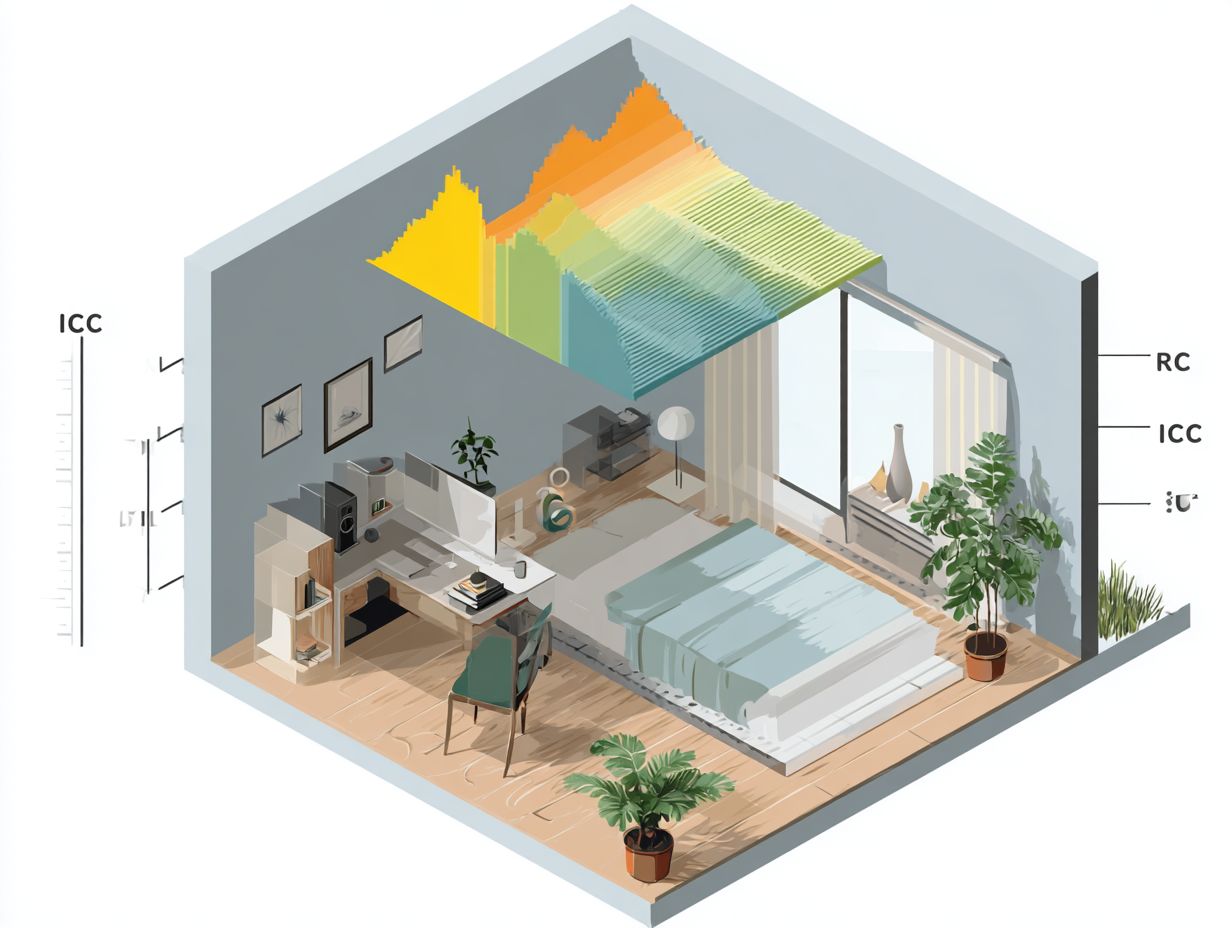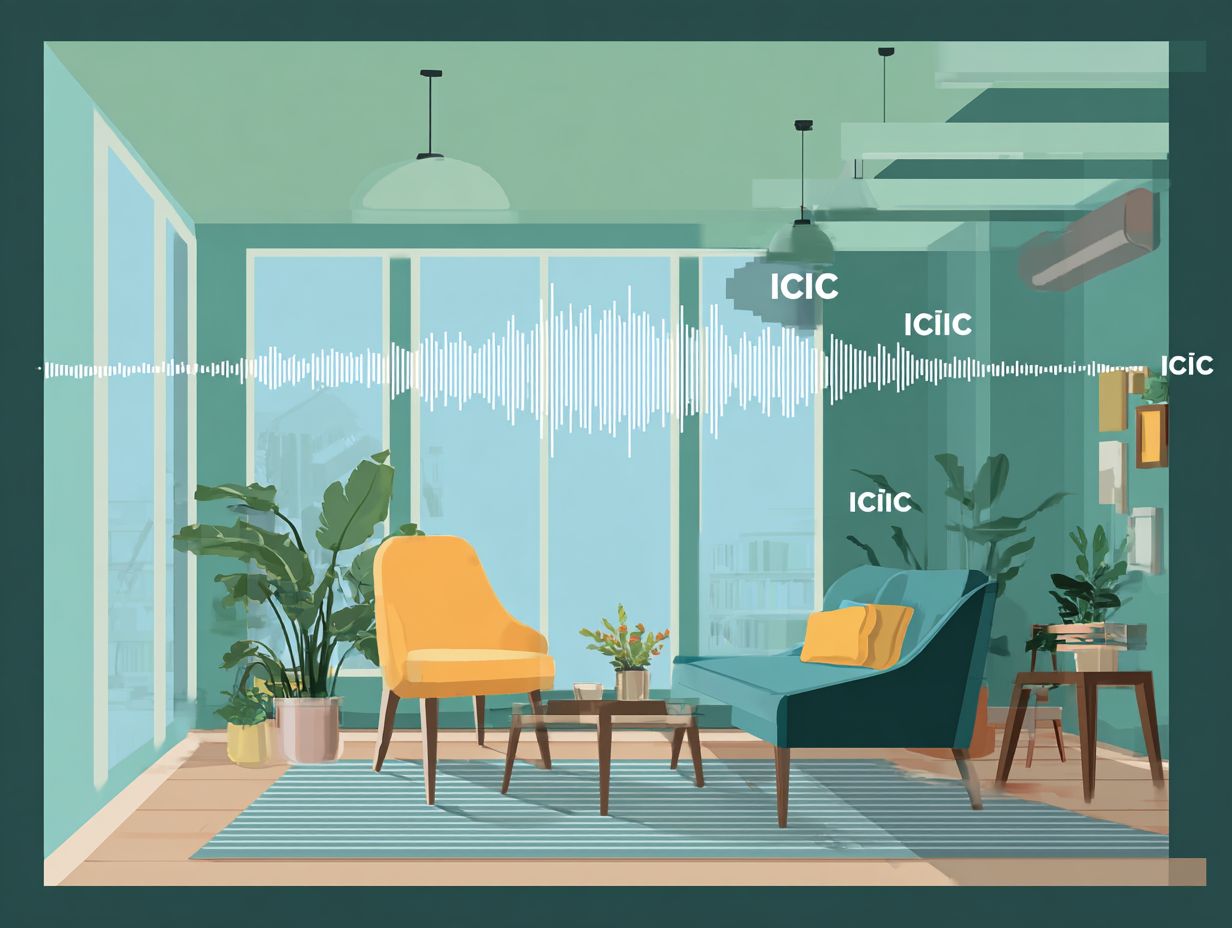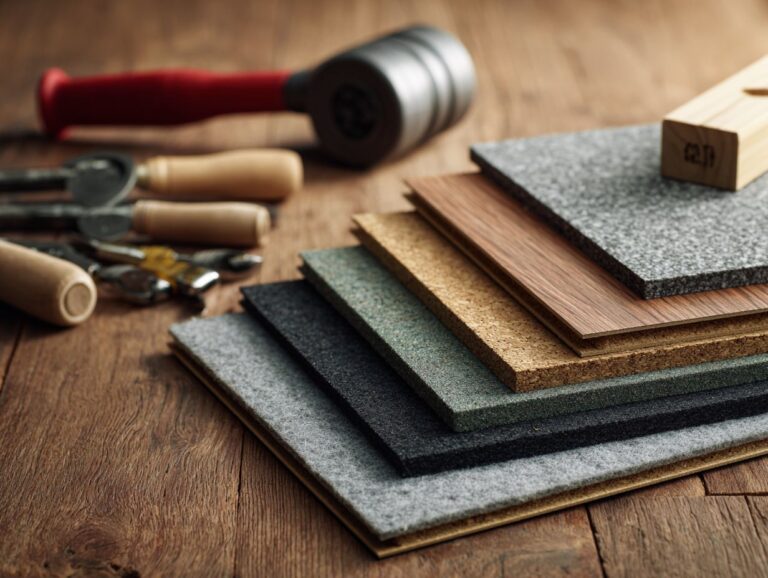Impact Insulation Class (IIC) Ratings Explained
Contents
- Introduction to Impact Insulation Class (IIC)
- Understanding Sound Transmission
- IIC Rating Scale
- Impact Insulation Class (IIC) Ratings Overview
- Factors Affecting IIC Ratings
- Testing Methods for IIC Ratings
- Applications of IIC Ratings
- Improving IIC Ratings
- Frequently Asked Questions
- What is Impact Insulation Class (IIC) and how is it measured?
- What factors affect the IIC rating of a floor or ceiling?
- What is a good IIC rating for soundproofing a space?
- Is a higher IIC rating always better?
- Can I improve the IIC rating of an existing floor or ceiling?
- How can I find out the IIC rating of a floor or ceiling?
Introduction to Impact Insulation Class (IIC)
 Learning about Impact Insulation Class (IIC) ratings is important for controlling impact noise and reducing sound movement between floors in homes and business spaces. Governed by ASTM International standards, IIC ratings help evaluate the effectiveness of floor-ceiling assemblies in acoustic testing. This article describes IIC ratings, their importance, and their practical application, guiding you in making informed decisions about soundproofing and enhancing the sound quality of your environment.
Learning about Impact Insulation Class (IIC) ratings is important for controlling impact noise and reducing sound movement between floors in homes and business spaces. Governed by ASTM International standards, IIC ratings help evaluate the effectiveness of floor-ceiling assemblies in acoustic testing. This article describes IIC ratings, their importance, and their practical application, guiding you in making informed decisions about soundproofing and enhancing the sound quality of your environment.
Key Takeaways:
Definition of IIC
Impact Insulation Class (IIC) measures how well floor-ceiling setups reduce impact noise, which is important for homes and businesses.
A high IIC rating means that a floor reduces noise well. This is important in places like apartment buildings or hotels, where too much noise can upset people living or staying there.
For instance, a building with an IIC rating of 50 or more can significantly dampen footfall sounds, while a rating below 40 may result in complaints about neighbors stomping above.
To enhance IIC, consider installing:
- Acoustic mats
- High-density flooring materials
- Incorporating resilient channels in drywall systems
These measures can mitigate noise and improve overall living conditions.
Importance of IIC Ratings
IIC ratings are important for meeting building codes, influencing how easy it is to sell and live in upscale homes and commercial spaces.
A high Impact Isolation Class (IIC) rating can greatly increase property value by providing effective soundproofing. For example, buildings that achieve a rating of 50 or above often attract tenants looking for quieter environments, thereby increasing demand.
To meet ASTM E2179 standards, use materials that reduce noise, like resilient channels or soundproof drywall, while building. Regular assessments using sound level meters can verify adherence to these ratings, ensuring tenant satisfaction and long-term value retention.
It’s important for construction professionals to understand these elements.
Understanding Sound Transmission
To handle sound problems in buildings well, it’s important to know the types of sound and how they move through different structures. Understanding the role of flooring materials can be crucial, as proper flooring underlayment installation significantly impacts sound insulation.
Types of Sound in Buildings
In buildings, sounds can be categorized into airborne noise, such as conversations, and impact noise, like footsteps, each requiring different soundproofing solutions.
Airborne noise usually moves through the air and impacts areas such as offices or classrooms, where it is important for speech to be clear. Effective soundproofing methods include adding acoustic panels or using double-glazed windows to reduce transmission.
On the other hand, impact noise, often encountered in multi-story buildings, can be mitigated by installing underlayment materials beneath flooring, such as cork or rubber mats, which absorb vibrations.
To get the best results, using both tactics-such as using resilient channels in wall building-creates a sound insulation plan suited to the building’s requirements.
How Sound Travels
Sound travels through solid materials via vibrations, with different frequencies experiencing varied transmission properties, influencing the choice of building materials.
To effectively manage sound transmission in floor assemblies, consider the Sound Transmission Class (STC) rating of your materials. For example, using resilient underlayments like rubber mats or foam can significantly improve STC ratings by dampening vibrations.
Materials with a high STC rating (noted above 50) are ideal for residential buildings where noise reduction is essential. Adding extra layers of drywall or soundproof insulation can reduce noise, creating quieter and more comfortable spaces.
IIC Rating Scale
The IIC rating scale goes from 0 to 110 and measures how well floor-ceiling setups block impact noise.
Higher numbers mean better noise control.
Impact Insulation Class (IIC) Ratings Overview
Impact Insulation Class (IIC) Ratings Overview
IIC Rating Breakdown: Standard IIC Ratings

The Impact Insulation Class (IIC) Ratings Overview Offers a thorough explanation of sound reduction standards for building materials and structures, concentrating on impact noise. These ratings are important for architects, builders, and building owners who want to improve sound comfort in homes and businesses.
IIC Rating Breakdown provides a clear view of different levels of sound reduction:
- Minimum Effective Sound Reduction: An IIC rating of 50 serves as the baseline for basic impact noise mitigation. This level is typically sufficient for general residential settings where noise is a concern but not a critical issue.
- Moderate Impact Noise Reduction: With an IIC rating of 60, materials provide a moderate level of sound insulation, suitable for multi-family dwellings and light commercial applications where higher noise disturbances are expected.
- Target for Home/Building Owners: Aiming for an IIC rating of 65 is recommended for home and building owners who prioritize quiet environments, especially in high-density living areas or noise-sensitive settings.
- High-rated Assemblies: Achieving an IIC rating of 85 provides excellent sound reduction, perfect for high-end homes, theaters, and recording studios where it’s important to have quiet and privacy.
These ratings help people involved in construction choose the right materials and plan for sound control. By selecting the appropriate IIC rating, it is possible to achieve the desired level of noise control, enhancing occupant satisfaction and property value.
Rating System Overview
The IIC rating system, defined by ASTM standards, evaluates the sound attenuation properties of various flooring materials in a controlled environment.
To find the IIC rating, tests are done on different factors like the material’s weight, size, and makeup.
For example, concrete flooring often achieves high IIC ratings due to its mass and solid structure, while laminate floors typically score lower due to their lighter weight.
In testing, materials like cork and carpet padding can greatly improve sound absorption, leading to higher overall IIC scores. Think about these factors when choosing flooring to make sure it blocks sound well for homes or businesses.
Interpreting IIC Values
Sound ratings are important for architects and builders. Ratings over 50 usually mean good noise protection in homes.
To make good design decisions, you need to know the acceptable IIC ranges for different building types. For instance, multifamily housing typically aims for an IIC rating of 55 to 60, while commercial spaces often target 50 or higher.
When choosing materials, think about using sound-absorbing products like acoustic insulation, which can greatly improve these ratings. Incorporating floating floors or resilient channels can further mitigate noise transmission, helping achieve desired acoustical performance.
Always do complete testing to make sure your projects meet these standards.
Factors Affecting IIC Ratings
IIC ratings are affected by different things like the materials used in the building, how the building is constructed, and where impact noise comes from inside the building.
Building Materials
The type of flooring material, such as luxury vinyl tile or rubber underlayment, greatly influences the overall IIC rating of a building’s floor-ceiling assembly.
For instance, luxury vinyl tiles (LVT) provide a moderate IIC rating due to their density and construction, which can effectively dampen sound transmission.
In contrast, rubber underlayment offers superior sound absorption, hence significantly improving the IIC rating when placed beneath hard surfaces.
Using these materials together can improve how they work; for example, using cork underneath engineered hardwood can help reduce noise well.
Make sure to use the right installation methods because any gaps or poor sealing can reduce how well it works, no matter what material you use.
Floor Construction Types
Using strong underlayers and good structural planning in floor construction can greatly improve the soundproofing levels in buildings with multiple floors.
One effective method is to use a two-layer floating floor system, which can significantly reduce the passage of sound. For instance, using a combination of concrete subfloors and acoustically rated drywall helps absorb vibrations.
A case study from Seattle demonstrated a 20% improvement in IIC ratings by implementing such a system in an apartment complex. Employing soundproofing materials like mass-loaded vinyl in the construction phase can further mitigate noise.
Frequent testing during and after setup checks that building codes are met and improves sound quality.
Impact Sources
Common impact sources, such as footsteps and falling objects, can create low-frequency noise that challenges even the best soundproofing materials.
To effectively mitigate these sounds, consider using a combination of techniques.
- First, installing mass-loaded vinyl (MLV) can provide excellent sound dampening, especially in floors.
- Next, apply acoustic underlayment beneath flooring materials to absorb vibrations.
- Using resilient channels on walls can decouple them, reducing the transmission of noise.
- For ceilings, a dropped ceiling with acoustic panels will offer further soundproofing.
Picking the right materials for your particular setting and budget is important for reducing noise effectively.
Testing Methods for IIC Ratings
Accurate IIC testing is necessary to check how well a building lowers sound, following ASTM rules.
Standard Testing Procedures

Standard tests for IIC, such as the ASTM E492 and E989 methods, use a tapping machine to imitate impact noise in a controlled environment.
This setup involves a few key steps.
- First, make sure the test space meets the set standards, like room size and types of surfaces.
- Position the tapping machine at specific heights, as dictated by ASTM guidelines.
- Once calibrated, the machine activates, generating a series of impacts that are recorded by sensitive microphones on the receiving floor.
- Data is analyzed using standardized methods to compute the Impact Insulation Class (IIC) rating.
- Following these rules every time is important for making accurate comparisons between different flooring systems.
Equipment Used in Testing
Essential equipment for IIC testing includes specific tapping machines and microphones made to correctly record and study sound transmission.
These tapping machines, such as the Brel & Kjr Type 8202, create controlled impacts that simulate sound energy transfer through building structures. Paired with high-sensitivity microphones like the Audio-Technica AT2020, they make sure even quiet sounds are recorded clearly.
It’s important to set up your equipment in a quiet place to prevent background noise, which can affect the results. Regular calibration before tests makes data more reliable, allowing for more accurate assessments of sound insulation performance.
Applications of IIC Ratings
IIC ratings are used in different places and affect design choices in homes and business areas to make people more comfortable.
Residential Buildings
In residential buildings, achieving a high IIC rating is essential for tenant satisfaction, particularly in multi-family housing where noise complaints can lead to tenant turnover.
To improve IIC ratings, you can use thick carpets with padding and sturdy floor underlayment.
For instance, a case study in a Toronto apartment complex saw a significant reduction in noise complaints by using Soundproofing Underlayment (like Cork or Rubber) under hardwood floors.
Installing sound-absorbing materials on walls and ceilings, such as acoustic panels, can further mitigate noise transmission. This approach improves comfort and helps retain tenants by creating a more tranquil living environment.
Commercial Spaces
For commercial spaces, IIC ratings significantly affect productivity and employee satisfaction, particularly in open-plan offices where noise can be distracting.
Knowing IIC (Impact Insulation Class) ratings is important for choosing the right flooring materials. Businesses have noticed that using carpets with high IIC ratings can make employees more comfortable by lowering noise levels.
For example, installing high-density acoustic tiles or underlayment can effectively improve IIC scores and create a quieter environment. Companies like Tech Solutions improved their workspace by installing cork flooring. This change increased their IIC rating from 50 to 65 and resulted in a 20% rise in employee satisfaction.
Focus on evaluating and enhancing IIC ratings to create a productive work environment.
Improving IIC Ratings
To improve IIC ratings, choose suitable materials and use effective methods to reduce noise.
Soundproofing Techniques
Effective soundproofing techniques, such as adding resilient underlayments and acoustic panels, can dramatically improve a building’s IIC ratings.
One effective method is installing a quality resilient underlayment, like Cork or MLV (Mass Loaded Vinyl), which can significantly diminish impact noise. For example, a project in a multi-family housing unit saw an IIC improvement of 10 points after such installations.
Putting acoustic panels in specific spots in shared spaces can soak up sound waves, cutting down on echoes. In an office setting, fabric-covered panels improve appearance and increase sound absorption, leading to higher productivity.
Using both methods together provides a complete way to reduce noise, customized for different spaces.
Material Recommendations
Choosing the right materials, such as rubber underlayment and acoustic underlay, is critical for achieving high IIC ratings in both residential and commercial projects.
For best results, think about using cork underlayment. It helps reduce noise and keeps in heat.
Luxury vinyl tile combined with foam layers improves appearance and reduces noise, reaching IIC ratings over 50. Brands like Armstrong and Mapei offer specialized products designed for maximum sound attenuation.
Installing these materials correctly-ensuring there are no gaps-can significantly lower noise levels, making them ideal for apartment buildings and office spaces.
Future of IIC Ratings

IIC ratings will likely see progress in soundproofing technology and materials, influencing building design.
Innovations such as mass timber, recycled materials, and advanced acoustic membranes are gaining traction. For example, using engineered wood products can greatly improve sound absorption while being eco-friendly.
Testing methods are changing, using actual data analysis to more accurately evaluate audio performance in different situations. These improvements make it easier to follow IIC ratings and lead to better energy efficiency in building design, which will likely affect regulatory standards and market expectations.
Final Thoughts
Knowing IIC ratings is important for architects, builders, and homeowners because they handle the demands of today’s sound insulation requirements.
To effectively address sound insulation, stakeholders should focus on key elements such as selecting materials with high IIC ratings, like acoustic ceiling tiles or resilient floor underlayment.
For instance, using products like QuietWalk (rated IIC 70) for flooring can significantly reduce impact noise. Improving sound quality can be achieved by using soundproof methods like separating walls with flexible metal channels.
Frequently reviewing the current IIC standards and consulting with acoustical engineers helps maintain effective soundproofing methods that comply with building rules, ensuring good decisions for optimal sound insulation.
Frequently Asked Questions
What is Impact Insulation Class (IIC) and how is it measured?
Impact Insulation Class (IIC) is a rating used to measure the impact sound insulation performance of a floor or ceiling structure. The measurement involves using a standard test to replicate the sound of footsteps on the floor, and the noise produced is recorded in decibels (dB).
What factors affect the IIC rating of a floor or ceiling?
The IIC rating is affected by various factors including the type and thickness of the flooring material, the subfloor structure, and the underlayment used. These factors can significantly impact the sound insulation performance of the floor or ceiling and thus the IIC rating.
What is a good IIC rating for soundproofing a space?
A good IIC rating for soundproofing a space is typically between 50-60. This means the floor or ceiling can decrease impact noise by 50-60 decibels, making it hard for sound to pass through and bother people in nearby areas.
Is a higher IIC rating always better?
Although a higher IIC rating is usually preferred, it might not be required or suitable for all areas. In some cases, a slightly lower IIC rating may still provide sufficient soundproofing and save on costs. It is important to consider the unique needs and requirements of each space when determining the ideal IIC rating.
Can I improve the IIC rating of an existing floor or ceiling?
Yes, it is possible to improve the IIC rating of an existing floor or ceiling. This can be done by altering the type and thickness of the flooring material, adding extra layers beneath the flooring, or using other methods such as placing acoustic insulation or soundproofing mats.
How can I find out the IIC rating of a floor or ceiling?
The IIC rating of a floor or ceiling can be found on the product’s packaging or by consulting with the manufacturer. You can use a sound level meter to measure and find out the IIC rating for a certain floor or ceiling setup yourself.



